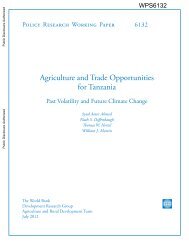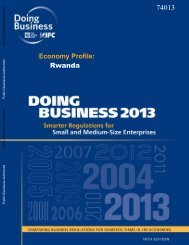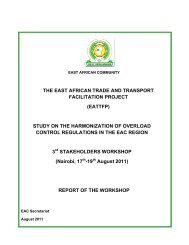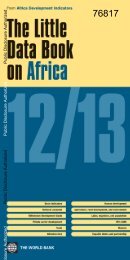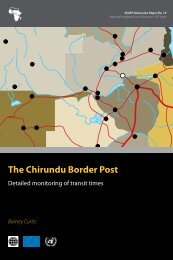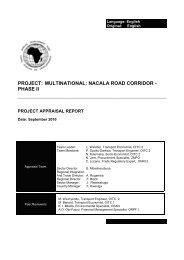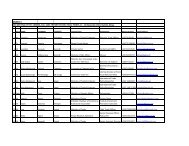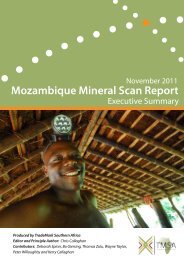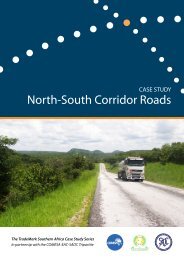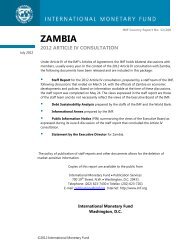Plant Health, Climate Change and Trade - TradeMark Southern Africa
Plant Health, Climate Change and Trade - TradeMark Southern Africa
Plant Health, Climate Change and Trade - TradeMark Southern Africa
Create successful ePaper yourself
Turn your PDF publications into a flip-book with our unique Google optimized e-Paper software.
1 <br />
SPS, climate change <strong>and</strong> trade<br />
A literature review on the possible effects on plants pests <strong>and</strong> diseases <strong>and</strong> the trade<br />
in plants <strong>and</strong> plant products <strong>and</strong> the likely impact of climate change on trade in plants<br />
<strong>and</strong> plant products within the tripartite region (EAC-COMESA-SADC)<br />
COP 17 negotiations – Durban<br />
7 th December 2011<br />
Marianna Theyse<br />
TMSA, in support of the COMESA-EAC-SADC Tripartite, commissioned this paper for<br />
the COP17 <strong>Climate</strong> <strong>Change</strong> Conference in Durban, 2011<br />
Executive Summary<br />
The effects of climate change on the patterns of plant pest <strong>and</strong> disease dispersal is<br />
potentially huge <strong>and</strong> largely unanticipated. These effects include the direct consequences of<br />
emerging crop pests <strong>and</strong> diseases as well as indirect effects on agricultural productivity <strong>and</strong><br />
trade.<br />
National regulatory systems in the Tripartite Region (COMESA, EAC <strong>and</strong> SADC Free <strong>Trade</strong><br />
Area) are therefore increasingly challenged to manage existing <strong>and</strong> new phytosanitary risks.<br />
Several examples of climate change induced pest <strong>and</strong> disease outbreaks that impacted on<br />
food security <strong>and</strong> resulted in economic losses of US$ billion in the region are provided in this<br />
brief.<br />
It is crucial to underst<strong>and</strong> the link between climate change <strong>and</strong> phytosanitary risks as<br />
strengthening of phytosanitary systems can help to mitigate the negative effects of climate<br />
change on crop production <strong>and</strong> thereby enhance food security <strong>and</strong> support safe agricultural<br />
trade. Considerable further investments in research will be needed to improve our<br />
underst<strong>and</strong>ing of the potential risks <strong>and</strong> to develop appropriate risk management<br />
technologies <strong>and</strong> measures. Furthermore, the gap between phytosanitary research <strong>and</strong><br />
policy making must be bridged to develop the necessary adaptive capacities <strong>and</strong> strategies<br />
that will enable vulnerable countries to manage emerging phytosanitary risks.<br />
Care should be taken that phytosanitary risks are integrated in the broad spectrum of climate<br />
change implications when preparing risk management strategies. At farm-level, climatesmart<br />
agriculture offers some unique opportunities to tackle food security issues that arise<br />
with changing or emerging plant pest <strong>and</strong> disease risks. At regulatory level, national<br />
phytosanitary systems must be capable to detect emerging plant pest <strong>and</strong> disease risks as<br />
early as possible <strong>and</strong> be prepared to promptly respond to these risks.<br />
Regional Economic Communities play an important coordinating role to create awareness<br />
<strong>and</strong> facilitate information exchange <strong>and</strong> regional cooperation to address emerging risks<br />
posed by trans-boundary pests <strong>and</strong> diseases. Regional research <strong>and</strong> development projects<br />
such as surveillance <strong>and</strong> training of national phytosanitary experts are needed to strengthen<br />
national phytosanitary capacities.<br />
COP 17 -‐ <strong>Trade</strong>mark <strong>Climate</strong> change impact on phytosanitary risks
2 <br />
1. Statement of the issue<br />
Determining adaptive strategies for the Tripartite Region (COMESA, EAC <strong>and</strong> SADC Free<br />
<strong>Trade</strong> Area) to respond to the impact of <strong>Climate</strong> <strong>Change</strong> on the resilience of plant pests <strong>and</strong><br />
diseases that affect <strong>Africa</strong>n agri-business <strong>and</strong> the likely necessity for increased<br />
phytosanitary st<strong>and</strong>ards <strong>and</strong> capacities to combat the spread of new phytosanitary risks.<br />
2. Introduction<br />
The Intergovernmental Panel on <strong>Climate</strong> <strong>Change</strong> (IPCC) states that substantial changes in<br />
average temperatures <strong>and</strong> rainfall will take place as a result of changing <strong>and</strong> intensifying<br />
human activities <strong>and</strong> consumption pattern <strong>and</strong> will increase the frequency <strong>and</strong> magnitude of<br />
extreme weather events. Research on the effects of climate change on agriculture have<br />
mostly focused on the how abiotic factors such as temperature, humidity <strong>and</strong> Co2 levels will<br />
affect crop production but the effects of climate change on biotic factors such as weeds, pest<br />
<strong>and</strong> diseases have not received much attention.<br />
<strong>Climate</strong> change is however, already impacting on phytosanitary systems as recent studies<br />
by the World Bank, the Food <strong>and</strong> Agriculture Organisation (FAO) of the United Nations, the<br />
Consultative Group on International Agricultural Research (CGIAR) <strong>and</strong> others indicate. It is<br />
expected that the impact of climate change on the capacity of phytosanitary systems will<br />
increase in future.<br />
Research studies have been undertaken to determine the effect of climate change on the<br />
prevalence <strong>and</strong> dispersion potential of pests <strong>and</strong> diseases, the increase of new disease<br />
outbreaks <strong>and</strong> the development of adaptive plant health strategies to control risks associated<br />
with trans-boundary pests <strong>and</strong> diseases in developing countries. Studies indicate that the<br />
effect of climate change on phytosanitary risks are likely to be greater in the tropics <strong>and</strong> in<br />
areas of significant water stress in <strong>Africa</strong>. The question to pursue is not whether climate<br />
change will result in new phytosanitary risks but rather what the type, scale <strong>and</strong> tempo of the<br />
changes in phytosanitary risk will be <strong>and</strong> how they will subsequently impact on food security<br />
<strong>and</strong> agricultural trade.<br />
Globalization, population growth, ecosystem diversity <strong>and</strong> resilience, pollution, l<strong>and</strong> <strong>and</strong><br />
water use, atmospheric composition, host-pest interactions <strong>and</strong> changing agricultural trade<br />
patterns are all interdependent <strong>and</strong> interact with climate change as contributing factors to<br />
increase <strong>and</strong> change the occurrence of plant pests <strong>and</strong> diseases that may negatively affect<br />
crop production, market access <strong>and</strong> maintenance. National phytosanitary systems are<br />
therefore continuously challenged to manage the complex <strong>and</strong> changing phytosanitary risks<br />
associated with crop production <strong>and</strong> trade.<br />
Various policies <strong>and</strong> institutions exist that manage phytosanitary problems around the world.<br />
Most policies are developed <strong>and</strong> implemented at national level <strong>and</strong> are based on<br />
international st<strong>and</strong>ards <strong>and</strong> regulations. The International <strong>Plant</strong> Protection Convention<br />
(IPPC) is acknowledged by the World <strong>Trade</strong> Organisation's Agreement on the Application of<br />
Sanitary <strong>and</strong> Phytosanitary Measures (WTO SPS Agreement) as the international st<strong>and</strong>ard<br />
setting organisation plant health. The quality of national SPS policies <strong>and</strong> the capacity of<br />
COP 17 -‐ <strong>Trade</strong>mark <strong>Climate</strong> change impact on phytosanitary risks
3 <br />
national SPS systems to implement policies vary among countries <strong>and</strong> will affect countries'<br />
ability to deal with new SPS risks created by climate change.<br />
3. The impact of climate change on phytosanitary risks<br />
The relationship between climate, plants <strong>and</strong> plant pests <strong>and</strong> diseases can be explained by<br />
the "disease triangle" as changes in CO2 concentration in the atmosphere, seasonality,<br />
temperature <strong>and</strong> rainfall threatens to change world patterns of comparative advantage in<br />
crop production by creating new ecological niches that will affect crop production <strong>and</strong> alter<br />
the distribution, incidence <strong>and</strong> intensity of plant pests <strong>and</strong> diseases.<br />
Temperature can affect critical stages (e.g. survival between seasons or reproduction rate)<br />
in the life cycle of plant pests <strong>and</strong> pathogens that cause plant disease. <strong>Change</strong>s in<br />
temperature <strong>and</strong> humidity may affect the susceptibility of host plants <strong>and</strong> therefore lower<br />
plant resistance to emerging pests or it may have an effect on the development of fungal<br />
<strong>and</strong> bacterial diseases. Furthermore, higher CO2 levels may increase the competition<br />
pressure between weeds <strong>and</strong> crops, the abundance of certain pathogens, such as rusts, or<br />
may increase foliar density <strong>and</strong> leaf wetness that makes infection by fungal pathogens more<br />
likely.<br />
The emergence of unexpected pests <strong>and</strong> diseases that occur because of changing climatic<br />
conditions have been observed when new vectors, selection <strong>and</strong> recombination of disease<br />
genotypes occur, when plant species <strong>and</strong> varieties mix, <strong>and</strong> when pests <strong>and</strong> vectors are<br />
introduced without their natural enemies.<br />
Climatic conditions have been drivers of the evolution of many migratory systems as<br />
migratory pests exploit seasonal changes <strong>and</strong> weather conditions that may assist or hamper<br />
their dispersal. Migratory pests such as locusts <strong>and</strong> the <strong>Africa</strong>n armyworm are unusual<br />
because they undergo density-dependant phase changes from solitary to gregarious <strong>and</strong> are<br />
dependent on temperature, rain <strong>and</strong> vegetation. When there is sufficient rain, migrations will<br />
take the insects to patches of green vegetation for feeding <strong>and</strong> to habitats humid enough for<br />
them to lay eggs. Studies indicate that migration patterns are changing with current changes<br />
in temperature <strong>and</strong> humidity. Altered wind patterns may also contribute to the changes in the<br />
spread of wind-borne pests <strong>and</strong> diseases.<br />
Many plant species are adapted to specific habitats that occupy a narrow range along<br />
altitudinal <strong>and</strong> latitudinal climatic gradients. As temperatures increase an upward migration<br />
of plant communities <strong>and</strong> their associated pests <strong>and</strong> disease vectors occur at high-altitude<br />
locations such as the East <strong>Africa</strong>n highl<strong>and</strong>s. Any increase in the frequency or severity of<br />
extreme weather conditions such as droughts, heat waves, windstorms or floods may also<br />
disrupt the predator-prey relationships that normally keep pest populations in check.<br />
4. The likely impact of new phytosanitary risks on trade<br />
Aflatoxins are mycotoxins that cause developmental <strong>and</strong> immune system suppression,<br />
cancer, <strong>and</strong> death <strong>and</strong> pose serious health risks for humans <strong>and</strong> animals in <strong>Africa</strong>. <strong>Change</strong>s<br />
in temperature <strong>and</strong> humidity may predispose host crops such as maize <strong>and</strong> groundnuts to<br />
aflatoxin contamination because of altered crop development <strong>and</strong> by affecting insects that<br />
COP 17 -‐ <strong>Trade</strong>mark <strong>Climate</strong> change impact on phytosanitary risks
4 <br />
create wounds on which aflatoxin-producing fungi proliferate. According to the FAO, 25<br />
percent of world food crops are affected with aflatoxin <strong>and</strong> countries situated within 40<br />
degrees latitude of the equator are most at risk. Aflatoxin contamination is widespread <strong>and</strong><br />
often acute in Sub-Saharan <strong>Africa</strong> where maize production is significant as livestock feed<br />
<strong>and</strong> as a staple food that accounts for 42 percent of all cereal crops in the region.<br />
Groundnuts is an important cash crop in the region that are largely controlled by women.<br />
Because of food safety regulations that aim to reduce human exposure to aflatoxins, crop<br />
contamination cause significant economic losses along the supply chain. A World Bank<br />
study estimates an annual loss of US$670 million to <strong>Africa</strong>n food exporters from attempting<br />
to meet the EU health regulation on aflatoxin.<br />
In April 2004, rural Kenya experienced one of the world's largest documented aflatoxicosis<br />
outbreaks resulting in 317 cases <strong>and</strong> 125 deaths. The source of the outbreak was linked to<br />
home grown maize harvested in February during unseasonably early rains <strong>and</strong> stored under<br />
wet conditions conducive to fungal growth. Contaminated maize entered the market<br />
distribution system when local farmers sold a portion of their household stores to market<br />
vendors. Market maize was found to be a significant source of continued exposure to<br />
aflatoxin long after contaminated household stores were consumed or discarded. This<br />
means that the potential role of the market system in sustaining exposure must be<br />
considered when public health assessments on aflatoxin outbreaks are done. The outbreak<br />
in Kenya occurred during a time of regional <strong>and</strong> national food shortages due to prolonged<br />
drought <strong>and</strong> crop failure. Immediate response efforts mainly focused on food replacement<br />
<strong>and</strong> relief whilst the need for a comprehensive food safety programme was realised.<br />
Several research studies <strong>and</strong> projects have since been done, or are in progress, to test preharvest<br />
<strong>and</strong> post-harvest technologies <strong>and</strong> good agricultural practices that may reduce the<br />
aflatoxin risk in <strong>Africa</strong>n agriculture. The International Food Policy Research Institute (IFPRI)<br />
is leading a project that was initiated in 2009, to analyze the impact <strong>and</strong> possible control<br />
measures of aflatoxin contamination on the livelihoods <strong>and</strong> health of people in Kenya <strong>and</strong><br />
Mali. This project has been launched in conjunction with the International Maize <strong>and</strong> Wheat<br />
Improvement Center (CIMMYT), International Crop Research Institute for the Semi-Arid<br />
Tropics (ICRISAT), University of Pittsburgh, Uniformed Services University of the <strong>Health</strong><br />
Sciences, Kenya Agricultural Research Institute, Institut d’Economie Rurale (Mali),<br />
ACDI/VOCA, <strong>and</strong> the East <strong>Africa</strong>n Grains Council. Research to date shows that a variety of<br />
field management practices, chemical control, biological control, postharvest practices <strong>and</strong><br />
timely harvesting may reduce aflatoxin development <strong>and</strong>/or contamination. However,<br />
efficient monitoring <strong>and</strong> surveillance with cost-effective sampling <strong>and</strong> analytical methods is<br />
needed in the region. COMESA is involved in the development of a Partnership for Aflatoxin<br />
Control in <strong>Africa</strong> (PACA) that will aim to support the implementation of cost-effective aflatoxin<br />
management programs <strong>and</strong> technologies, focusing on entire value chains to ensure a holistic <strong>and</strong><br />
integrated approach for aflatoxin control. Better underst<strong>and</strong>ing of the potential impact of<br />
climate change will allow development of improved management procedures, better<br />
allocation of monitoring efforts, <strong>and</strong> adjustment of agronomic practices in anticipation of<br />
global climate change to reduce the risk of aflatoxin contamination. Public education <strong>and</strong><br />
awareness is considered to play an important role to sensitize the population on aflatoxin<br />
risk <strong>and</strong> its management.<br />
COP 17 -‐ <strong>Trade</strong>mark <strong>Climate</strong> change impact on phytosanitary risks
5 <br />
Stem rust (black), stripe rust (yellow) <strong>and</strong> leaf rust (brown) are the most economically<br />
damaging diseases affecting wheat production <strong>and</strong> recently there has been an escalation in<br />
the threat posed by both stem <strong>and</strong> stripe rust. Several variants are now recognized <strong>and</strong> the<br />
emergence of the Ug99 races in East <strong>Africa</strong> transformed stem rust from a disease largely<br />
under control into a significant global threat. It was first reported in Ug<strong>and</strong>a in 1999 <strong>and</strong> is<br />
now also present in Ethiopia, Kenya, South <strong>Africa</strong>, the Sudan <strong>and</strong> Zimbabwe. This disease<br />
is capable of yield losses of between 10 - 70 percent depending on inoculum pressure <strong>and</strong><br />
environmental conditions <strong>and</strong> is spread over long distances via wind-borne spores. In South<br />
<strong>Africa</strong>, the spread of wheat stripe rust has been linked to changes in rainfall patterns. In<br />
Kenya wet <strong>and</strong> misty conditions, following successive rainfall seasons since November<br />
2009, are making Ug99 even harder to control. The subsequent use of fungicides have<br />
been estimated to increase production costs by 40 percent with most impact on small-scale<br />
farmers that are responsible for 80 percent of wheat production in the country.<br />
In 2010 the FAO launched a website "SPORE” that aims to provide up-to-date information<br />
on the status of wheat stem rust, monitor important new strains of the disease <strong>and</strong><br />
synthesize <strong>and</strong> provide easy access to reliable data on a global scale. Although the Ug99<br />
pathogen is not seed-borne, there is still potential for introduction with plant debris or as<br />
seed contaminant when germ-plasm or wheat grain is imported for consumption <strong>and</strong><br />
quarantine measures such as sampling <strong>and</strong> testing may be required. Countries will need to<br />
take pre-emptive action with sustained investment in research, surveillance, a strategies for<br />
crop diversity, <strong>and</strong> policies to encourage farmers to adopt disease-resistant crop varieties.<br />
Experts propose a framework development for regional surveillance with primary target<br />
regions being major wheat producers in <strong>Africa</strong> (Ethiopia, Kenya, Sudan, <strong>and</strong> Eritrea) with<br />
support from international scientists for training <strong>and</strong> data management. The East <strong>Africa</strong><br />
program under the Borlaug Global Rust Initiative (BGRI) aims to minimize scale <strong>and</strong> scope of<br />
stem rust epidemics in Kenya <strong>and</strong> Ethiopia by means of monitoring (screening) <strong>and</strong> control, <strong>and</strong><br />
to prevent that new virulent <strong>and</strong> dangerous forms originating from this region leave East <strong>Africa</strong>.<br />
Cassava is considered by experts to be a highly resistant crop that can endure high<br />
temperatures <strong>and</strong> drought <strong>and</strong> therefore has significant potential in <strong>Africa</strong>n agriculture<br />
threatened by the effects of climate change. However, a major constraint to cassava<br />
production is the emergence of new pests <strong>and</strong> diseases that can be attributed to climate<br />
change. In <strong>Africa</strong>, whiteflies are causing direct damage to crops <strong>and</strong> indirect damage as<br />
they are vectors of Cassava Brown Streak Disease (CBSD) <strong>and</strong> Cassava Mosaic Disease<br />
(CMD). CBSD has been reported to cause up to 80 percent yield losses in East <strong>Africa</strong> <strong>and</strong><br />
occurs along the coast of East <strong>Africa</strong>, in an area extending from Kenya south to the Zambezi<br />
River in Mozambique, <strong>and</strong> along the shores of Lake Malawi in Malawi <strong>and</strong> Tanzania, but not<br />
along the shoreline in Mozambique. Angola is suggested to be a probable area to find the<br />
disease, due to cultural <strong>and</strong> economic ties to Mozambique. In 2007, a study by the<br />
International Institute of Tropical Agriculture (IITA) projected that at least 40 million people<br />
have been affected by CBSD in Tanzania with annual losses of US$50 million. CMD has<br />
been reported in all countries in <strong>Africa</strong> <strong>and</strong> affects domestic cassava <strong>and</strong> wild hosts. Studies<br />
on CMD in 1990 by Fauquet <strong>and</strong> Fragette, <strong>and</strong> in 2009 by Patil <strong>and</strong> Fauguet, estimate yield<br />
losses of up to 50% on average in <strong>Africa</strong>, with annual economic losses of US$ 1.9-2.7 billion<br />
in East <strong>and</strong> Central <strong>Africa</strong>. In Rw<strong>and</strong>a, surveillance conducted by the National Agricultural<br />
Research Institute in 2010 showed a 15.7 percent rate of infection of CBSD on local cassava<br />
varieties <strong>and</strong> 36.9 percent in improved varieties.<br />
COP 17 -‐ <strong>Trade</strong>mark <strong>Climate</strong> change impact on phytosanitary risks
6 <br />
A study done in 2011 by the International Center for Tropical Agriculture (CIAT) indicates a<br />
high potential for combined outbreaks of whitefly, green mite, CMD <strong>and</strong> CBSD in <strong>Africa</strong>'s Rift<br />
Valley that could lead to a collapse in production <strong>and</strong> ultimately threaten food security in the<br />
region. Scientists are working on the development of cassava varieties that are resistant to<br />
whitefly, green mite <strong>and</strong> CMD. Further studies in taxonomy <strong>and</strong> dispersal patterns of the<br />
disease vectors are required on local, l<strong>and</strong>scape <strong>and</strong> regional scales to determine<br />
appropriate early warning <strong>and</strong> management strategies <strong>and</strong> policies that would control the<br />
pest <strong>and</strong> disease distribution to unaffected areas. Scientists have monitored the spread of<br />
CMD <strong>and</strong> CBSD in central <strong>and</strong> East <strong>Africa</strong> for several years but costs have been high <strong>and</strong><br />
annual visits to the region barely kept pace with the spread. And so the Digital Early<br />
Warning Network (DEWN) was established <strong>and</strong> piloted in Tanzania. Farmer groups were<br />
involved <strong>and</strong> information received was used to generate maps <strong>and</strong> allow research teams to<br />
concentrate mitigation efforts in areas where new outbreaks occurred. In 2010 it was<br />
decided to exp<strong>and</strong> the project to Rw<strong>and</strong>a.<br />
The movement of plant propagation material used in agricultural research, crop<br />
diversification, food production <strong>and</strong> commercial trade pose significant phytosanitary risks.<br />
New pests <strong>and</strong> disease may easily result in outbreaks of epidemic proportions when<br />
introduced into areas where there is no resistance or competition. In the 1970's the cassava<br />
green mite was accidentally introduced into <strong>Africa</strong> <strong>and</strong> spread to almost all cassava<br />
producing regions resulting in losses of 30-50 percent. In 1993 a biological control agent<br />
from Latin America was introduced to assist in its control. The accidental introduction of<br />
bunchy top virus affected more than 3000ha banana production in Malawi <strong>and</strong> completely<br />
destroyed production in Nkhota, Khota <strong>and</strong> Nkhatabay. Therefore national plant protection<br />
organisations have developed strict risk based phytosanitary measures that include visual<br />
inspection during active growth, virus-indexing, blotter testing <strong>and</strong> sedimentation essays for<br />
seeds, to prevent the introduction of pests <strong>and</strong> diseases by means of propagation material.<br />
True seeds <strong>and</strong> in-vitro propagation material are considered expensive but also the safest<br />
phytosanitary management options for exchange of propagating material. In 2007, the<br />
Great Lakes Cassava Initiative (GLCI) was implemented to ensure plant health of<br />
propagating material in Burundi, Democratic Republic of Congo, Kenya, Rw<strong>and</strong>a, Tanzania<br />
<strong>and</strong> Ug<strong>and</strong>a, especially in the light of recent p<strong>and</strong>emics of CBSD.<br />
The prevalence <strong>and</strong> spread of fruit flies in <strong>Africa</strong> will alter considerably because of climate<br />
change <strong>and</strong> will result in corresponding changes in phytosanitary regulations, intra-regional<br />
<strong>and</strong> international trade opportunities. Fruit flies are one of the world's most devastating fruit<br />
<strong>and</strong> vegetable pests <strong>and</strong> cause millions of US$ losses in crop production each year. In <strong>Africa</strong><br />
there are several species that attack crops <strong>and</strong> wild hosts. Since its first detection in Kenya<br />
in 2003, the fruit fly Bactrocera invadens has spread to at least 27 countries in <strong>Africa</strong> <strong>and</strong><br />
became a major pest of economic <strong>and</strong> quarantine concern. It is known to attack at least 46<br />
host plants, including many indigenous plant species <strong>and</strong> commercially grown crops such as<br />
mango, guava, pumpkin, melon, tomato, citrus <strong>and</strong> cashew nuts. Equatorial climates in<br />
<strong>Africa</strong> are considered most suitable for the establishment of B. invadens. The introduction<br />
<strong>and</strong> establishment of this fruit fly can severely impact on sustainable agriculture <strong>and</strong> rural<br />
livelihoods, as well as access to export markets because of its quarantine status in other<br />
countries. The detection of B. invadens in Mozambique, northern Namibia <strong>and</strong> Zambia<br />
resulted in the suspension of all host plant exports to South <strong>Africa</strong>. And for the same reason,<br />
COP 17 -‐ <strong>Trade</strong>mark <strong>Climate</strong> change impact on phytosanitary risks
7 <br />
South <strong>Africa</strong> has strict import requirements for horticulture products destined from East<br />
<strong>Africa</strong>. Horticulture Exporters from Kenya, Rw<strong>and</strong>a, Tanzania <strong>and</strong> Ug<strong>and</strong>a have failed to<br />
access the SA lucrative market because of the fruit fly problem. This highlights the necessity<br />
to establish the extent <strong>and</strong> status of invasive flies , the implementation of surveys <strong>and</strong><br />
monitoring together with the private sector, for the establishment of Pest Free Areas (PFAs)<br />
<strong>and</strong> Areas of Low Pest Prevalence (ALPPs) <strong>and</strong> research into the biology, ecology <strong>and</strong><br />
appropriate post harvest treatments to mitigate the effects of this pest in the Tripartite<br />
Region.<br />
Technical support for fruit fly projects in the <strong>Africa</strong>n region is mainly provided though the<br />
International <strong>Plant</strong> Protection Convention (IPPC) which is administered by the FAO, the<br />
World Bank <strong>and</strong> the United States Department of Agriculture (USDA); Agriculture <strong>and</strong> <strong>Plant</strong><br />
<strong>Health</strong> Inspection Service (APHIS) <strong>and</strong> Foreign Agriculture Service (FAS). The Centre of<br />
Insect Physiology <strong>and</strong> Ecology (ICIPE) in Kenya is providing fruit fly taxonomy training <strong>and</strong><br />
involved with several research projects on fruit fly control <strong>and</strong> management. The Citrus<br />
Research International (CRI) funded a project by ICIPE on cold sterilisation for B. invadens<br />
on citrus <strong>and</strong> other projects for treatments on avocado <strong>and</strong> mango are underway.<br />
Migratory pests patterns are expected to change as a results of the impact of climate<br />
change. For example, more winter rain in recession areas such as North <strong>Africa</strong> <strong>and</strong> the<br />
Sahel may provide better breeding conditions that may trigger more locust outbreaks.<br />
Swarming locusts may move downwind so that convergent winds may take them to areas<br />
with higher rainfall. In some cases, such as the northward movement across the Sahara in<br />
autumn, prevailing north-easterly winds would blow insects back in the "wrong" direction but<br />
locusts have adapted not to take off under such conditions, possible because the northeasterly<br />
winds are too cold. In SADC the Information Core for <strong>Southern</strong> <strong>Africa</strong> Migratory<br />
Pests ICOSAMP was established as a central point of migrant pest information for all SADC<br />
countries, a ‘peer-to-peer’ network of information officers <strong>and</strong> control operators <strong>and</strong> a<br />
st<strong>and</strong>ardized regional reporting system with the aim to enhance technical co-operation &<br />
sharing of research information in the region.<br />
5. The impact of climate change on phytosanitary risk management<br />
At farm level, climate change may result in extended growing seasons that will subsequently<br />
affect the implementation <strong>and</strong> duration of crop protection practices. In many developing<br />
countries extension services are unable to provide adequate crop protection services to<br />
farmers <strong>and</strong> climate change is likely to exacerbate the problem by increasing the need for<br />
crop protection. Biological control practices will be affected as bio-control agents are<br />
generally sensitive to environmental variation or extremes. Chemical management practices<br />
will also be affected during higher winter temperatures when more generations or higher<br />
pest populations occur <strong>and</strong> the frequency of pesticide use is increased or during periods of<br />
higher rainfall when contact fungicides are washed out. Subsequently, agricultural input<br />
costs will increase <strong>and</strong> more negative impacts on the environment is expected.<br />
In 2008, the Consultative Group on International Agricultural Research (CGIAR) adopted a<br />
new System-wide Program on Integrated Pest Management (SP-IPM) with the aim of<br />
improving the adaptation of IPM to climate change. The programme includes research <strong>and</strong><br />
outreach programs on crop pest <strong>and</strong> disease management by pulling together the individual<br />
COP 17 -‐ <strong>Trade</strong>mark <strong>Climate</strong> change impact on phytosanitary risks
8 <br />
strengths <strong>and</strong> expertise of several CGIAR centers <strong>and</strong> their partners <strong>and</strong> then disseminating<br />
<strong>and</strong> promoting IPM information so it can be integrated in National Action Plans. It advocates<br />
<strong>and</strong> raises awareness on IPM with emphasis on adaptation to climate change, agro-eco<br />
system resilience <strong>and</strong> food safety. It also provides training <strong>and</strong> decision support tools on<br />
IPM.<br />
At a regulatory level, climate change may affect the pest risk analysis (PRA) process which<br />
informs phytosanitary decision making in accordance with the World <strong>Trade</strong> Organisation's<br />
Agreement on the Application of Sanitary <strong>and</strong> Phytosanitary Measures (WTO SPS<br />
Agreement). The PRA process provides the technical justification for countries to implement<br />
phytosanitary measures that should be least trade restrictive but will prevent the introduction<br />
of new pests into their territories. When determining the introduction potential <strong>and</strong><br />
quarantine status of pests <strong>and</strong> diseases risk assessors must take into consideration the<br />
impact of climate change on (i) pest <strong>and</strong> host distribution ranges (ii) establishment potential<br />
of potential pests (iii) phenological cycles of plants <strong>and</strong> (iv) synchronization between plants<br />
<strong>and</strong> their associated pests. This means that risk assessments will continually have to be reevaluated<br />
<strong>and</strong> updated as climate conditions continue to change. New uncertainties that<br />
affects the PRA process because of the effects of climate change may intensify perceptions<br />
of phytosanitary threats <strong>and</strong> subsequently influence the regulatory decision-making process<br />
in such a way that it would negatively impact on trade.<br />
Risk assessment <strong>and</strong> climate change were discussed at the third annual meeting of the<br />
Commission on Phytosanitary Measures (CPM) of the IPPC in 2008 <strong>and</strong> it was concluded<br />
that risk assessment should incorporate climate change models but some members<br />
cautioned against its use because of unwanted effects on phytosanitary regulations due to<br />
the uncertainties in the predictions of climatic models. Further concerns relating to risk<br />
assessment procedures that do not yet adequately address certain aspects of climate<br />
change such as the shifting of natural ranges of individual species. The use of climate<br />
change models in pest risk assessment was also discussed at a meeting on pest risk<br />
assessment organised by the European Food Safety Authority (EFSA) in 2007.<br />
During an FAO expert consultation on <strong>Climate</strong>-Related Trans-boundary Pests <strong>and</strong> Diseases,<br />
in 2008, the weak management of trans-boundary movements of pests <strong>and</strong> diseases in<br />
developing countries was identified as a challenge to global food <strong>and</strong> agricultural production<br />
<strong>and</strong> is likely to increase with the impact of climate change.<br />
Phytosanitary capacity building challenges exist at prevention, eradication <strong>and</strong> containment/<br />
management levels with containment being the most costly option <strong>and</strong> prevention usually<br />
being the most cost effective option. Prevention include early warning systems consisting of<br />
forecasting, early detection, early control <strong>and</strong> research. Border control is also essential to<br />
prevention <strong>and</strong> a part of the risk management system that are often subject to trade<br />
disputes.<br />
The FAO’s Emergency Prevention System for Trans-boundary Animal <strong>and</strong> <strong>Plant</strong> Pests <strong>and</strong><br />
Diseases (EMPRES) provides for international plant pest <strong>and</strong> disease reporting but national<br />
diagnostic <strong>and</strong> reporting capacity constraints exists. Furthermore, concerns regarding the<br />
impact of disease reporting on trade may limit countries' willingness to report new pest or<br />
disease outbreaks. Few developing countries have early warning systems that can<br />
COP 17 -‐ <strong>Trade</strong>mark <strong>Climate</strong> change impact on phytosanitary risks
9 <br />
undertake such tasks. The FAO has proposed building regional early warning systems as an<br />
alternative to inadequate national systems.<br />
Many countries have insufficient resources, <strong>and</strong> lack appropriate regulatory frameworks <strong>and</strong><br />
adequate phytosanitary capacities to apply control measures at production level, conduct<br />
risk assessment, surveillance <strong>and</strong> monitoring, border control <strong>and</strong> inspections, <strong>and</strong> provide<br />
diagnostic services <strong>and</strong> effective information management. These challenges are likely to<br />
increase as climate change intensify the dem<strong>and</strong>s for improved phytosanitary management<br />
at national, regional <strong>and</strong> global level.<br />
6. Adaptation strategies to address the impact of climate change on<br />
phytosanitary systems<br />
Several initiatives to develop adaptation strategies to address the impact of climate change<br />
on agriculture exist such as the <strong>Climate</strong> for Development in <strong>Africa</strong> Programme (ClimDev). In<br />
2008 the German Government funded another research programme focused on "Adaptation<br />
of <strong>Africa</strong>n agriculture to climate change".<br />
Five international research institutes (i.e. the International Potato Centre (CIP), the<br />
International Crops Research Institute for the Semi-Arid Tropics (ICRISAT), the International<br />
Food Policy Research Institute (IFPRI), the International Livestock Research Institute (ILRI)<br />
<strong>and</strong> the International Water Management Institute (IWMI)), two German universities <strong>and</strong> a<br />
German research centre are involved in this programme that aims at building local capacity<br />
<strong>and</strong> using local knowledge through active involvement of non-governmental organizations,<br />
farmer associations <strong>and</strong> national agricultural research centres. However, many of these<br />
initiatives do not specifically relate to phytosanitary risks <strong>and</strong> special attention should be paid<br />
to integrate these risks in the development of climate change adaptation strategies. Wellintegrated<br />
adaptation strategies requires effective performing institutions <strong>and</strong> interinstitutional<br />
cooperation, especially where overlapping m<strong>and</strong>ates of government entities may<br />
lead to conflicts <strong>and</strong> slow responses.<br />
The EU released a White Paper on the Adaption to <strong>Climate</strong> <strong>Change</strong> in 2009 that sets out a<br />
framework to enhance EU resilience to the impacts of climate change <strong>and</strong> was supported by<br />
working documents to highlight five key priority actions in the areas of human, animal <strong>and</strong><br />
plant health. In North America several programmes address the impact of climate change<br />
on phytosanitary risks but no comprehensive framework exists. In Australia such research is<br />
done through the Australian Bio-security Cooperative Research Centre that reflects the ''one<br />
health'' concept.<br />
To assist developing countries in formulating policies to adapt to climate change in different<br />
fields, three funds have been set up: (i) the Least Developed Countries Fund (LDCF); (ii) the<br />
Special <strong>Climate</strong> <strong>Change</strong> Fund (SCCF) under the United Nations Framework Convention on<br />
<strong>Climate</strong> <strong>Change</strong> (UNFCCC); <strong>and</strong> (iii) the Adaptation Fund (AF) under the Kyoto Protocol.<br />
Another potential funding scheme to develop National Adaptation Action Plans (NAPA's) is<br />
the Global Environment Facility (GEF) Trust Fund's Strategic Priority for Adaptation (SPA).<br />
Agriculture is one of the priority areas in the development of NAPA's but little attention has<br />
so far been paid to include adaptation strategies specifically for emerging phytosanitary<br />
risks.<br />
COP 17 -‐ <strong>Trade</strong>mark <strong>Climate</strong> change impact on phytosanitary risks
10 <br />
The following adaptive phytosanitary strategies are proposed as technical <strong>and</strong> policy<br />
responses to climate change for the Tripartite Region:<br />
6.1. Strengthening national phytosanitary systems<br />
<strong>Climate</strong> change will bring new challenges in phytosanitary risk management that will require<br />
competent phytosanitary authorities <strong>and</strong> coherent regulatory frameworks. Policy options that<br />
bridge the gap between pure scientific knowledge <strong>and</strong> practical solutions will be key to<br />
effective adaptation strategies.<br />
Core capacity building in risk analysis, monitoring <strong>and</strong> surveillance, diagnostic services <strong>and</strong><br />
rapid diagnostic tools, inspections <strong>and</strong> border control, emergency preparedness <strong>and</strong><br />
response will be crucial in enabling developing countries to effectively manage new<br />
phytosanitary risks that may occur as a result of climate change.<br />
Improving access to international pest data bases <strong>and</strong> development of regional information<br />
exchange mechanisms that include distribution of pests <strong>and</strong> diseases <strong>and</strong> correlated<br />
ecological conditions including climate will assist in risk assessment, surveillance <strong>and</strong> control<br />
activities.<br />
6.2. Improving early warning systems<br />
Develop <strong>and</strong> ensure effective use of pest-monitoring <strong>and</strong> rapid response plans, participatory<br />
investigation, interception techniques, new screening technologies, forecasting <strong>and</strong> early<br />
warning networks.<br />
Surveillance monitors various aspects such as epidemiological, ecological <strong>and</strong> economic<br />
data to verify emergence of new markets, new trade channels, trade volumes <strong>and</strong> types of<br />
commodities. Risk-based surveillance in areas <strong>and</strong> places where pest introduction potential<br />
is high, such as ports of entry, will provide a focused means of early detection <strong>and</strong> thereby<br />
save resources.<br />
Developing <strong>and</strong> improving information networks for early warning systems is crucial <strong>and</strong> may<br />
be more cost-effective when done at a regional level whilst building on those of existing<br />
specialist institutions. The development of a notifications database of new pest outbreaks<br />
<strong>and</strong> interceptions in the region can be useful tools in developing early warning systems <strong>and</strong><br />
informing risk management decisions. Open-source information that is provided in real-time<br />
is therefore needed to strengthen national <strong>and</strong> regional data <strong>and</strong> allow decision makers<br />
additional time for planning <strong>and</strong> appropriate response actions.<br />
Developing early warning expertise <strong>and</strong> training of field workers on aspects such as<br />
sampling <strong>and</strong> trapping techniques <strong>and</strong> identification of exotic pests is required.<br />
6.3. Strengthening research<br />
<strong>Climate</strong> change may have positive, negative or no impact on individual plant pests <strong>and</strong><br />
diseases. A better underst<strong>and</strong>ing of the ecology of pests <strong>and</strong> their hosts, the correlations<br />
between them, <strong>and</strong> climate <strong>and</strong> impact modelling is necessary to predict the potential<br />
COP 17 -‐ <strong>Trade</strong>mark <strong>Climate</strong> change impact on phytosanitary risks
11 <br />
reaction of pests <strong>and</strong> diseases on climate change. Research is therefore needed to obtain<br />
base-line information on different pest or disease systems, improve risk assessment<br />
capacities <strong>and</strong> to close the knowledge gaps that exist.<br />
Taxonomic research <strong>and</strong> the development of diagnostic capabilities will be needed to<br />
promptly identify newly introduced species <strong>and</strong> thereby improve early warning <strong>and</strong> rapid<br />
response systems.<br />
More research in pre-harvest <strong>and</strong> post-harvest pest management <strong>and</strong> technologies (eg.<br />
development of resistant hosts or cultivars that are specifically adapted to changing climatic<br />
conditions, invasive weed control, chemical control, proper transportation <strong>and</strong> packaging,<br />
etc.) is needed to deal with climate induced changes in phytosanitary risks. Improving<br />
adaptive pest control strategies will alleviate the pressure on regulatory systems <strong>and</strong><br />
contribute to sustainable production <strong>and</strong> enhance food security as long as it is accompanied<br />
by measures to ensure that producers have access to these new improved technologies.<br />
Indigenous knowledge on how to deal with climate changes <strong>and</strong> pest risks should not be<br />
overlooked but incorporated in the research approaches <strong>and</strong> policy action plans. Structured<br />
engagements between all stakeholders including farmers, researchers <strong>and</strong> policy makers<br />
will assist in collaborative learning processes to better deal with the impacts of climate<br />
change.<br />
6.4. Improving phytosanitary decision-making<br />
Decision-making frameworks that are flexible enough to incorporate new knowledge when it<br />
becomes available <strong>and</strong> that consider costs <strong>and</strong> benefits of different risk management<br />
strategies are necessary to support prioritisation <strong>and</strong> improve resource allocation. Existing<br />
knowledge gaps must be bridged <strong>and</strong> effective linkages between research <strong>and</strong> policymaking<br />
should be developed.<br />
6.5. Including climate change implications in st<strong>and</strong>ard-setting <strong>and</strong> implementation<br />
New knowledge on the impact of climate change should be considered <strong>and</strong> incorporated<br />
during risk assessment <strong>and</strong> risk management activities. National <strong>and</strong> regional st<strong>and</strong>ards,<br />
guidelines <strong>and</strong> codes of practice should be revised accordingly.<br />
6.6. Identifying <strong>and</strong> implementing environmentally friendly phytosanitary measures<br />
The use of some phytosanitary control measures, eg. methyl bromide, contributes to climate<br />
change <strong>and</strong> should be avoided when alternative <strong>and</strong> equivalent measures are available<br />
whilst more research is required to find suitable replacement technologies.<br />
6.7. Educating stakeholders<br />
The linkages between climate change <strong>and</strong> phytosanitary risks must be considered <strong>and</strong><br />
awareness among all stakeholders, including policy-makers, phytosanitary experts, the<br />
private sector <strong>and</strong> general public, must be increased to enhance countries' capacity to<br />
respond to new phytosanitary risks.<br />
COP 17 -‐ <strong>Trade</strong>mark <strong>Climate</strong> change impact on phytosanitary risks
12 <br />
6.8. Focusing on Interdisciplinary approaches<br />
Environmental health, human, animal <strong>and</strong> plant health <strong>and</strong> food safety are interrelated, <strong>and</strong><br />
connected to other global change factors such as globalization <strong>and</strong> technological changes.<br />
The "One World One <strong>Health</strong>'' model as described by the Wildlife Conservation Society<br />
(WCS) provides a framework for a more coordinated <strong>and</strong> holistic approach.<br />
Interagency coordination <strong>and</strong> collaboration in countries should be enhanced e.g. through<br />
joint research, investigation of risks, training, etc. to ensure efficient control efforts.<br />
6.9. Mainstreaming adaptation in development cooperation <strong>and</strong> SPS capacity building.<br />
Ministers responsible for Agriculture <strong>and</strong> representatives of Countries present at the <strong>Africa</strong>n<br />
Ministerial Conference on <strong>Climate</strong>–Smart Agriculture “<strong>Africa</strong>: A Call to Action" , called on the<br />
<strong>Africa</strong>n Union <strong>and</strong> other partners to mainstream climate change principles into the<br />
Comprehensive <strong>Africa</strong>n Agricultural Development Programme (CAADP) <strong>and</strong> to further<br />
support the implementation of the AUC-‐NEPAD Agriculture <strong>and</strong> <strong>Climate</strong> <strong>Change</strong> Adaptation-‐<br />
Mitigation Framework.<br />
The World Bank's World Development report 2010 focused on the impact of climate change<br />
on development. The report states that poverty reduction <strong>and</strong> sustainable development<br />
remains core global priorities but climate change must be addressed as it threatens<br />
development goals with most impact on poor countries <strong>and</strong> poor people. The reports urges<br />
countries to act now <strong>and</strong> act together <strong>and</strong> to adapt development policies that are climate<br />
sensitive <strong>and</strong> not postpone mitigation in developing countries as such approaches could<br />
double mitigation costs later. Early action is therefore needed to identify <strong>and</strong> scale up best <br />
practice for climate-‐smart agriculture, to build capacity <strong>and</strong> experience, <strong>and</strong> to help clarify <br />
future choices.<br />
A study done by the World Bank in Mozambique found that integrating adaptation measures<br />
across all sectors <strong>and</strong> institutional levels is important to safeguard existing <strong>and</strong> future<br />
development progress in light of climate change. The study identified organisational barriers<br />
<strong>and</strong> opportunities for mainstreaming adaptation into development assistance. It states that<br />
government plays an important role to improve institutional coordination <strong>and</strong> integration of<br />
cross-cutting issues, including phytosanitary concerns <strong>and</strong> food security, into development<br />
planning. However, specialists in environmental units across all relevant sector institutions<br />
are needed to identify <strong>and</strong> develop adaptation strategies <strong>and</strong> to strengthen organisational<br />
capacity to address climate change risks <strong>and</strong> improve the network for awareness.<br />
Mainstreaming adaptation in development cooperation <strong>and</strong> phytosanitary capacity building<br />
will require efforts to raise awareness about the implications of climate change for SPS risks,<br />
<strong>and</strong> the benefits of SPS capacity building for adaptation as well as trade <strong>and</strong> development.<br />
6.10. Forming public-private partnerships <strong>and</strong> the role of the public sector<br />
Institutional weaknesses of the National <strong>Plant</strong> Protection Organisations (NPPO's) in<br />
developing <strong>and</strong> least developed countries were explicitly recognized during the incorporation<br />
of the World <strong>Trade</strong> Organization's Agreement on Sanitary <strong>and</strong> Phytosanitary Measures into<br />
COP 17 -‐ <strong>Trade</strong>mark <strong>Climate</strong> change impact on phytosanitary risks
13 <br />
the overall establishment of the WTO in 1994. Many of these weaknesses still persist<br />
despite significant efforts to address capacity problems. Strong public private partnerships<br />
can assist to overcome some of these weaknesses.<br />
A good example is the National Exotic Fruit Fly Surveillance Programme that are being<br />
conducted by the South <strong>Africa</strong>n Department of Agriculture, Forestry <strong>and</strong> Fisheries (DAFF):<br />
Directorate <strong>Plant</strong> <strong>Health</strong> as a collaborative approach between the South <strong>Africa</strong>n government,<br />
affected fruit industries <strong>and</strong> research institutes. The project was started in January 2006,<br />
when a network of fruit fly traps was set up as an early warning system to detect exotic fruit<br />
flies, such as Bactrocera invadens, also known as the Invader fruit fly. The South <strong>Africa</strong>n<br />
fruit industry was recognised as a key role player to assist with the surveillance.<br />
Subsequently, Citrus Research International (CRI), Citrus Growers' Association (CGA), the<br />
Deciduous Fruit Producers Trust (DFPT/Hortgro), the South <strong>Africa</strong>n Table Grape Industry<br />
(SATI) <strong>and</strong> the Subtropical Growers Association became more intensely part of the official<br />
national exotic fruit fly detection survey. A National Steering Committee, that included<br />
representatives from affected industries, was established by DAFF to coordinate <strong>and</strong><br />
communicate activities related to the surveillance programme. The Steering Committee<br />
developed a National Action Plan for Bactrocera invadens surveillance, containment <strong>and</strong><br />
eradication that was implemented in South <strong>Africa</strong> <strong>and</strong> made available for use to other<br />
countries in the region. The Action Plan contains a survey protocol, quarantine <strong>and</strong><br />
eradication procedures, information management guidelines <strong>and</strong> highlights stockpiling<br />
as an important aspect of preparedness. This early warning system paid off in 2010<br />
when South <strong>Africa</strong> experienced the first detections of Bactrocera invadens in the<br />
Limpopo Province <strong>and</strong> outbreaks were successfully contained <strong>and</strong> eradicated. In<br />
anticipation of potential future trade implications for fruit exports to countries such as the<br />
United States, trapping efforts were extended in the 2011/12 citrus production season to<br />
include all exporting production units in the citrus industry. It is anticipated that these<br />
trapping requirements for export will be further exp<strong>and</strong>ed to other potentially affected<br />
industries in South <strong>Africa</strong>.<br />
6.11. Developing regional initiatives <strong>and</strong> the role of EAC, COMESA <strong>and</strong> SADC<br />
Regional coordination will be required to effectively deal with trans-boundary pests <strong>and</strong><br />
diseases such as fruit flies. The development of regional surveillance programmes <strong>and</strong> pest<br />
information systems will support inadequate national capacities. However, functional<br />
national surveillance systems may be used as building blocks for such regional systems.<br />
SADC, EAC <strong>and</strong> COMESA should compile information on areas of phytosanitary expertise in<br />
different Member States for sharing in order to encourage the exchange of knowledge within<br />
the region. This is especially important to save time <strong>and</strong> costs as successfully implemented<br />
or completed initiatives may provide insight into practical considerations (lessons learnt) that<br />
should be included into planning of new <strong>and</strong> similar initiatives in other areas or countries.<br />
Regional SPS committees provide ideal platforms to facilitate information exchange,<br />
harmonisation <strong>and</strong> cooperation amongst members.<br />
A STDF report published in 2010, states that the expansion of regional consciousness <strong>and</strong><br />
the establishment of Regional Economic Communities (REC's) ''carry the potential for an<br />
COP 17 -‐ <strong>Trade</strong>mark <strong>Climate</strong> change impact on phytosanitary risks
14 <br />
improved approach on SPS matters''. It analysed regional SPS policy frameworks, including<br />
those of COMESA, EAC <strong>and</strong> SADC, <strong>and</strong> warns against using WTO SPS language out of<br />
context in these regional frameworks that could create confusion, raise legal concerns, <strong>and</strong><br />
in extreme cases raises the questions of the utility of such frameworks. It therefore<br />
recommends that existing SPS policy frameworks should be carefully reviewed in terms of<br />
their practical utility, to eliminate any duplication or contradiction with regard to the WTO<br />
SPS Agreement.<br />
The report further encourages active participation in of REC's in meetings of International<br />
St<strong>and</strong>ard Setting Organisations (ISSO's) <strong>and</strong> the WTO SPS Committee as experience<br />
shows that such participation facilitates the task of Member States. The report also<br />
recommends that " REC's should promote regional <strong>and</strong> national coordination by taking the<br />
lead in organizing systematic preparation meetings of technical experts in advance of<br />
important ISSOs meetings <strong>and</strong>, whenever possible, develop continental/regional common<br />
positions on matters of common interest''.<br />
COMESA, EAC <strong>and</strong> SADC should also put a strong accent on the need for the creation or<br />
strengthening of existing national SPS Committees <strong>and</strong> increase awareness of SPS issues<br />
at political <strong>and</strong> general public levels. Training may be provided for officials who attend or<br />
participate in these national or regional SPS Committees. Capacity-building efforts should be<br />
focused on dem<strong>and</strong>-driven activities, that are identified through capacity evaluations, <strong>and</strong><br />
should involve all relevant stakeholders.<br />
By using the various existing transparency tools developed by the WTO SPS Committee<br />
instead of duplicating systems for the publication <strong>and</strong> notification of SPS measures,<br />
unnecessary administrative burdens may be avoided. COMESA, EAC <strong>and</strong> SADC may<br />
assist members by receiving, screening <strong>and</strong> disseminating WTO SPS notifications of interest<br />
to the region.<br />
COP 17 -‐ <strong>Trade</strong>mark <strong>Climate</strong> change impact on phytosanitary risks
“





